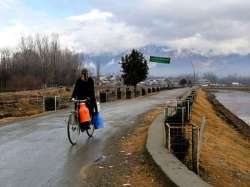North India shivers under extreme cold conditions; mercury in Delhi drops to 4.2 degrees Celcius
Extreme cold conditions have taken over the whole of North India. Reportedly, most stations in the capital have recorded severe cold conditions continuously for 12 days. Delhi had also experienced cold wave spell in four years -1997, 1998, 2003, and 2014.

Delhiites woke up to a severely cold day on Friday as the minimum temperature in Delhi dropped to 4.2 degrees Celcius. The India Meteorological Department had earlier said the national capital likely to record its second-coldest December since 1901 as temperatures are predicted to drop further. Mercury is predicted to drop to 4 degrees Celsius over the weekend, the MeT had said. On Wednesday, the minimum temperature in Delhi was recorded at 5.8 degrees Celsius while maximum was 13.4 degrees Celsius, seven notches below normal.
Other than Delhi, the whole of North India continues to reel under extremely cold conditions with Rajasthan's Sikar recording the season's lowest night temperature at minus 3 degrees Celsius.
The Drass belt of Kargil district, meanwhile, was the coldest place in the twin Union Territories of Jammu-Kashmir and Ladakh recording a minimum temperature of minus 30.2 degrees Celsius.
According to yet another forecast by the India Meteorological Department (IMD) on Thursday, cold wave conditions would continue till the end of the year in many states in north India.
The capital is already in the midst of the longest cold wave in December seen in 22 years.
The IMD, in a statement, said that considering the prevailing meteorological conditions, cold day to severe cold day conditions in many pockets are very likely to continue till December 29 over Punjab, Haryana, Chandigarh and Delhi and Uttar Pradesh and in some pockets over north Rajasthan, cold day conditions at isolated pockets also very likely over Madhya Pradesh and Bihar but abating thereafter.
Reportedly, most stations in the capital have recorded severe cold conditions continuously for 12 days. Delhi had also experienced cold wave spell in four years -1997, 1998, 2003, and 2014.
The severe cold conditions are prevailing due to the persistence of cold northwesterly winds in lower levels over northwest India and other favourable meteorological conditions. Since December 15, many states in northern India are reeling under severe cold wave conditions.
According to the IMD, the most severity was observed on December 25, when majority of stations in the region recorded 7-12 degrees Celsius below average with actual maximum temperature of the day varying between 9-15 degrees Celsius. "The lowest day maximum temperature on this date in the plains was reported at Ganganagar and Chandigarh with 9 degrees Celsius," said the IMD statement.
The capital recorded a severe cold day on Wednesday with the maximum temperature dropping to 12.7 degrees Celsius, which is nine degrees below the average, while the minimum temperature was 6 degrees Celsius, two degrees below the average.
The minimum temperature on Wednesday night was recorded at 6 degrees Celsius and the weather bureau said it was 7 degrees Celsius at 5.30 a.m. on Thursday.
The IMD also predicts light/moderate isolated to scattered rain/thundershowers over Punjab, Haryana, Chandigarh and Delhi, north Rajasthan and Uttar Pradesh between December 31, 2019 to January 2, 2020.
"Isolated thunderstorm/hailstorm at isolated places is also likely to occur over south Uttar Pradesh on January 1 & 2 2020," it added.
Also Read | North India shivers in cold wave; Fatehpur in Rajasthan records minus 3°C
Also Read | Delhi in for second-coldest December since 1901